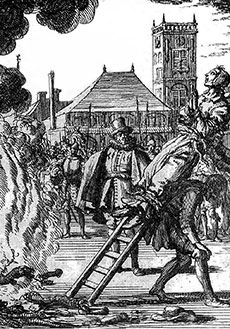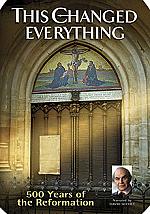A fire that spread

“Anabaptist” was a dirty name in sixteenth-century Christian Europe; it was deemed a dangerous movement, a call for violent destruction of Europe’s religious and social institutions.
The name simply means, in Greek, “one who baptizes again,” but this tiny group aroused opposition from all sides. Rulers and theologians, whether Protestant or Catholic, regarded early Anabaptist success with a mixture of fear and anxiety. They were thought to be political revolutionaries bent on destroying the unity of the faith. Some even argued that they were a special spawn of Satan, who had always found pious-acting adherents throughout the centuries.
An illegal Bible study
What, besides adult baptism, was behind the movement that flowed from Huldrych Zwingli’s teaching in Zurich? And were Anabaptists as dangerous as the world seemed to think?
Darkness had already fallen on January 21, 1525, when, one by one, a half-dozen men could be seen furtively entering a house in Zurich near the Grossmünster (Zurich’s most prominent church) in violation of a law passed earlier that same day by the City Council prohibiting their assembly. The occasion for this meeting behind closed shutters: Bible study and prayer.
Group meetings for Bible study were well known in Zurich. Scholars and other interested people had met frequently since 1520, often with Zwingli himself in attendance. But on this particular occasion, Zwingli was not invited. Major disagreements had arisen regarding the role of the City Council in the progress of reform in Zurich.
Zwingli was committed to letting the council set the pace of reform. Since he was convinced that the council was a Christian council, this position harmonized with his insistence that only Christians could make changes in the church.
But the council dragged its feet based on economic and political considerations. Conrad Grebel (c. 1498–1526), Felix Manz (c. 1498–1527), and others believed that neither prudence nor fear shouldpreventobedienceto Christ.
Moreover Grebel and Manz concluded from their study of the New Testament that the name “Christian” could be applied only to those who truly follow Jesus and not indiscriminately to all who are baptized. Finally, they denied that the government (even if Christian) should have authority to decide the pace of reform.
Zwingli did not share these views. Grebel, Manz, and several others began to meet by themselves to study the Bible further. Two Zurich priests from the Bible study group, Wilhelm Reublin and Johannes Brötli, had already begun to preach against infant baptism in 1524 in the villages of Witikon and Zollikon outside Zurich. This was too much for Zwingli. He and the council agreed that the group was now a threat to the unity and peace of Zurich. The council ordered them to conform to the law of baptism and forbade them to meet together.
The men who gathered in Manz’s house that winter night were aware of the seriousness of what they were doing. But they became more and more convinced that they had no choice but to obey God who had led them to their new and dangerous understanding. And then—if the account in the sixteenth-century Hutterian Chronicle is accurate—they felt suddenly compelled to give concrete form to their obedience. Amid prayer and the certainty of persecution, they baptized one another and in the same moment commissioned each other to build Christ’s church on earth.
This action made them missionaries. In the days following, they baptized others, especially some farmers from the nearby village of Zollikon. They continued to meet for Bible study and prayer and also to celebrate the Lord’s Supper. Persecution followed immediately. Many were arrested and put in prison. After harassment for three or four months by imprisonment and the threat of exile, this first “free” church disintegrated.
But the leaders had been busy elsewhere. Grebel preached and baptized in Schaffhausen and St. Gall; George Blaurock (1491–1529), a former monk, went to the Grisons and the Austrian Tyrol. In May 1525 Eboli Bolt became the first Anabaptist martyr, burned at the stake for his faith in the town of Lachen in the Swiss canton of Schwyz. A year later Grebel died of the plague away from home, and in January 1527 Manz was publicly executed.
New and strange words
By that time, two years after the formation of the first congregation, the movement had spread for hundreds of miles. Peasants and townsfolk displayed an openness to the Anabaptists early on and did so without much inquiry as to their reputed heretical views.
All Europe was awash in fresh religious fervor. Though many people were disturbed by drastic changes in religious practices that they thought could harm the faith of simple, transparent, and steadfast Christians, many others believed the freshly opened Bible led to novel ways of understanding and living out its message.
Order Christian History #118: The People’s Reformation in print.
Subscribe now to get future print issues in your mailbox (donation requested but not required).
A peasant carting his onions to market; a furrier plying his craft in north German towns; a housewife or nun to whom some new word about Christ or the saints raised questions about religious practice; a weaver or a shearer joining with fellow cloth makers in a Lowlands town; a schoolteacher whose natural theological curiosity pressed him to re-examine both Scripture and the Latin fathers—all of these and many more found themselves open to the new and strange words of itinerant Anabaptist missionaries. They spoke plainly to the common people and moved on to other towns and villages after only a few days of instructing new converts.
Peasants bitterly resented restrictions on hunting and fishing and the enforced payment of tithes to a church that they considered corrupt. Townsfolk were caught in economic cycles with downturns that no one understood. They all resented the wealth and privileges of their local clergy and especially of monasteries near at hand.
To such people an Anabaptist gospel of simple discipleship and shared goods so that none were needy appeared to be deeply and properly Christian—the way God would have his people live. Of course a few upper-class people also found the Anabaptist truth convincing.
By May 1526 an Anabaptist assembly was held in Augsburg under the leadership of the highly gifted Hans Denck (1495–1527). Denck had been expelled from Nuremberg in January 1525 for holding to ideas critical of the Lutheran teaching in that city. A restless fugitive from then until his death, Denck exercised a moderating influence on the Anabaptist movement in south Germany with his emphasis on love as the sum of all virtues and his reticence in judging others. He baptized Hans Hut (1490–1527) in the summer of 1526, and Hut became one of the most zealous and successful of all Anabaptist missionaries, founding churches all over Austria. His method was to preach, baptize converts, then immediately appoint other missionaries to be sent out. Although many of these “apostles” were executed, the movement still
spread rapidly.
Hut’s activities prompted the rise of communal Anabaptism in Moravia. In 1528 a group of Anabaptists decided to combine their resources for a common life of work, discipleship, and worship. Their most important early leader was Jacob Hutter (1500–1536), who gave the Hutterites their name and for seven years worked to rescue them from the terror of Hapsburg persecution in the Tyrol (part of modern Austria) and move them to the safety of Moravia. He was burned at the stake in Innsbruck in 1536. The Hutterite communities he founded thrived under relative toleration in Moravia and sent successive waves of missionaries to many parts of Europe.
Not quite the end times
Meanwhile Lutheran preacher Melchior Hoffman (1495–1543) went to Strasbourg in 1529, where he met Anabaptists for the first time and quickly became one himself. He took his new views northward to the Netherlands and north Germany. Like Hans Hut he was a fiery preacher and baptized many converts. Numerous groups of “Melchiorites” emerged in the fertile spiritual soil of the Netherlands.
Hoffman had a special interest in the future events of the Second Coming and the millennium and fastened on Strasbourg as the New Jerusalem. He returned there and, in 1533, cheerfully went to prison because he believed that his imprisonment would set in motion the last events of human history. Instead he died in prison 10 years later.
In his place others took over leadership, and in their hands Hoffman’s speculations turned into dark tragedy. The movement had already produced its share of odd followers. In St. Gall, because the Gospel said that we must become as little children to enter the kingdom of God, some people literally behaved like children, playing with toys and babbling like babies. In Thuringia one Anabaptist claimed to be the Son of God. But it was in Münster where Anabaptists turned to violence
and oppression.
The city of Münster in Westphalia had first become Lutheran but by early 1533 was Anabaptist-leaning. Anabaptists from Amsterdam went there and announced that Münster, not Strasbourg, was the New Jerusalem. Jan Matthys (d. 1534) and Jan van Leiden (1509–1536), both unstable extremists, gained control. Hoffman had urged his followers to wait peaceably for God’s kingdom, but Matthys and Leiden taught that force would bring in the kingdom. They forced people to receive baptism and join the movement or leave the city. They also banned all books except the Bible.
These developments alarmed the prince-bishop who ruled over Münster, and he besieged the city. But before it was sealed off, thousands of Anabaptists from the Netherlands made a hopeful exodus to Münster in expectation of Christ’s triumphant return. Instead they found Jan van Leiden crowned as King David, ruling with an iron hand and instituting polygamy (he had 16 wives, one of whom, Elisabeth Wandscherer, he executed in the market square on June 12, 1535). On June 25, 1535, the city fell, its inhabitants slaughtered and no apocalypse in sight.
Now persecutors had what they believed to be ironclad evidence that Anabaptists, with all their insistence on nonviolence, were basically no less violent than anyone else. The authorities were convinced that persecution was the only way of containing this potential violence. They called the Anabaptists by many derogatory names:
• Schwarmer (fanatics who upset social convention)
• Winkelprediger (“corner-preachers” who conducted illegal religious enterprises in secret hideaways)
• Rottengeister (factionalists playing upon the grievances of the lower classes)
• Donatists (after the fourth-century group who considered themselves a spiritual elite)
• Aufrüherer (revolutionaries promoting civil disobedience and revolt under the guise of preaching and practicing religious piety).
Burning and drowning
It became increasingly dangerous even to listen to an Anabaptist missionary after some feudal lords began to obey the 1529 imperial mandate decreeing death to Anabaptists. Broadsides (essentially, early newspapers) broadcast the juicy details of events in Münster, and the larger movement suffered disgrace; even those who had declared nonviolence to be biblical some 10 years before Münster found themselves discredited.
Feudal lords, judges, bailiffs with responsibility for social order, and city magistrates all found the Anabaptists troubling. Their existence displayed a religious pluralism that no one in the sixteenth century was willing to accept. People thought that political chaos and even revolution were the only possible results of religious differences within a political body. And religiously earnest rulers felt a divine call to propagate the true faith among, and to regulate the moral behavior of, their subjects.
A few princes and magistrates—for example Philip of Hesse, Ulrich of Württemberg, and the Strasbourg Council—could not bring themselves to exercise the death penalty for religious offenses by Anabaptists. As Philip once declared, to do so would mean that one would need to kill all Jews and Catholics also. Some (in Moravia, for instance) felt that they could afford to harbor and protect Anabaptists, and reaped the benefits of their artisan and agricultural skills
in return.
But most rulers would not tolerate them. Many feared a reappearance of 1525’s peasant unrest and revolution (see “They wanted God to save his own,” pp. 18–21) and exiled them or had them executed. Catholic magistrates opted for the traditional burning at the stake (with a small bag of gunpowder tied around the victim’s neck to ensure an early death, as a humanitarian gesture), while Protestant magistrates chose drowning and beheading.
Catholic writers generally viewed Anabaptists as a wilder perversion of Protestantism and blamed Luther for the entire lot; a few reform-minded Catholics found some kinship of spirit with Anabaptists even while rejecting them as schismatic.
Only a few of the Protestant reformers demonstrated much sympathy for the Anabaptists’ religious views, among them Wolfgang Capito and Martin Bucer of Strasbourg. Katherine Schütz Zell, the dynamic, influential wife of Matthew Zell, Strasbourg’s cathedral preacher, offered Anabaptists protection. But by 1526 in Zurich, 1528 in south and central Germany, and 1532 in the Lowlands, reformers’ attitudes hardened.
A way of peace
Other reformers singled out the issue of baptism as decisive, even though to Anabaptists themselves it was only one issue among many in establishing a community of “real Christians.” To the Lutheran reformers, the denial of baptism to infants put their salvation in jeopardy. Zwinglians and Calvinists who denied the sacramental power of baptism still believed that the rejection of infant baptism excluded the child from the nurture and fellowship of God’s people.
By the 1550s there were formidable lists of Anabaptist “errors,” but most derived from accusations of blasphemy in baptism and sedition in nonswearing of oaths. Most reformers decided, sometimes after several years of soul-searching, that Anabaptists had to be killed for the good of society and the benefit of religious truth, though Luther never quite agreed. They were often pressed to come to this conclusion by rulers.
Lost in all the fear was the fact that Anabaptists, just as much as their opponents, saw the events at Münster as a terrible perversion of the Gospel and resolutely turned away from them. The most important person in the consolidation of nonviolent Anabaptism was former priest Menno Simons (1496–1561).
Simons worked tirelessly for a church order that preserved love of neighbor and the integrity of a church composed only of those who had consciously decided to follow Jesus. He continued his work for 25 years, most of that time with an imperial price on his head, and died in 1561. Seventeen years later his followers in the Netherlands were granted toleration.
His contemporary Pilgram Marpeck (d. 1556), a civil engineer, picked up the work laid down by Denck and Hut, who had both perished in 1527. Marpeck became the acknowledged leader of a group of Anabaptist fellowships in Alsace, Württemberg, and Moravia. Passionately devoted to the unity of the church, he was especially distressed that there was a division between south German Anabaptists and the Swiss Brethren, followers of Conrad Grebel.
Marpeck objected to legalistic use of the ban (exclusion from Communion or church membership) and hasty judgments about the failings of others. In contrast to the Netherlands, toleration did not come to south Germany, Switzerland, and Moravia for several more centuries. The movement practically disappeared in south Germany and was completely eradicated in Austria. It survived in Switzerland in small enclaves, but always under restrictions.
Even while the Anabaptist movement was persecuted by fire, water, and blood, it did not compromise its commitment to living by new rules even in the midst of the terrible power of the old. Four centuries ago Anabaptists knew and lived and died by their hope in the Resurrection, somehow certain that their faithfulness would be taken up into God’s great peace plan for mankind. Today they can be found all over the world under the names Mennonite, Brethren, and Amish—names now associated with peace. CH
This article is from Christian History magazine #118 The People’s Reformation. Read it in context here!
Christian History’s 2015–2017 four-part Reformation series is available as a four-pack. This set includes issue #115 Luther Leads the Way; issue #118 The People’s Reformation; issue #120 Calvin, Councils, and Confessions; and issue#122 The Catholic Reformation. Get your set today. These also make good gifts.
By Walter Klaassen and John Oyer
[Christian History originally published this article in Christian History Issue #118 in 2016]
Walter Klaassen is an adjunct professor of history in the College of Arts and Sciences at the University of Saskatchewan. John Oyer (1925–1998) was professor of history at Goshen College, director of the Mennonite Historical Library at Goshen, and editor of the Mennonite Quarterly Review. This article is adapted from ones by Klaassen and Oyer in CH 5.Next articles
The accidental revolution
The English Reformation began with a king but took hold among a people
Melinda S. ZookA motley, fiery crew
Sometimes difficult, always committed, these men advanced the Reformation in Germany, Switzerland, and England
David C. Steinmetz and Edwin Woodruff TaitThe people's Reformation: Recommended resources
Where can you go to learn more about the “people’s Reformation”? Here are some recommendations from CH editorial staff and this issue’s authors.
the editorsSupport us
Christian History Institute (CHI) is a non-profit Pennsylvania corporation founded in 1982. Your donations support the continuation of this ministry
Donate









